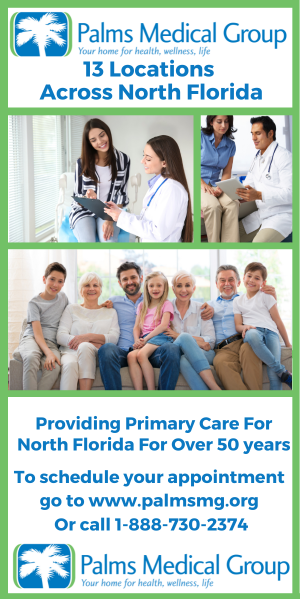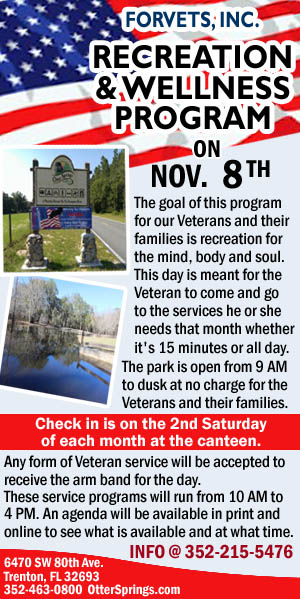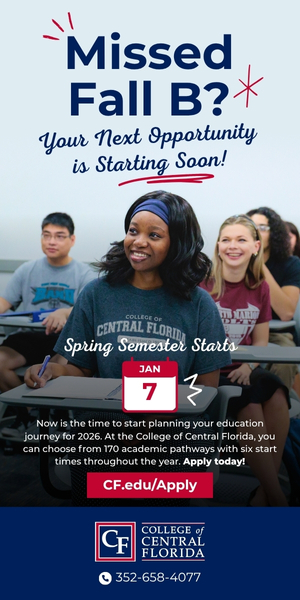

Click HERE to see and hear the most recent publication
of the HardisonInk.com jingle.
Elder Options provides information
for seniors impacted
by suspension of SNAP benefits
Information Provided
Published Nov. 6, 2025 at 3:30 p.m.
GAINESVILLE -- Due to the ongoing federal government shutdown, SNAP benefits will not be issued starting Nov. 1.
More Below This Ad
Older adults in need of food are encouraged to contact their local senior center or lead agency to learn more about congregate meal schedules or home-delivered meals.
Elder Options is proud to provide support for seniors across North Central Florida. Call the Elder Options Helpline 1-800-262-2243 Monday through Friday from 8 a.m. to 5 p.m. for more information and referrals for older adults, adults with disabilities, and caregivers in need.
To contact a county’s lead agency about reserving a meal, please use the directory below.
Need help finding additional food resources? Call the Elder Helpline at 1-800-262-2243 or 1-800-963-5337 for information about food banks, pop-up distributions, and other community assistance programs.
● Alachua County
Elder Care of Alachua County, Inc.
352-265-9040
https://eldercare.ufhealth.org/
● Bradford, Dixie, Gilchrist, Hamilton, Lafayette, Levy, Suwannee, and Union Counties
Suwanee River Economic Council, Inc.
904-964-6696 – Bradford County
352-498-5018 – Dixie County
352-463-2940 – Gilchrist County
386-792-1136 – Hamilton County
386-294-2202 – Lafayette County
352-490-7055 – Levy County
386-362-4115 – Suwannee County
386-496-2342 – Union County
https://srecinc.org/
● Columbia County
Columbia County Senior Services, Inc.
386-755-0235
https://www.columbiaseniors.org/
● Citrus County
Citrus County Support Services
352-527-5900
● Marion County
Marion Senior Services, Inc.
352-620-3501
https://www.marionseniorservices.org/
Community Food Resources
● Salvation Army, 639 E. University Ave., Gainesville 352-376-1743
● SWAG Family Resource Center, 807 S.W. 64th Terrace, Gainesville 352-505-6823
● Gainesville Community Ministry, 238 S.W. Fourth Ave., 352-372-8162
● Catholic Charities Gainesville, 1701 N.E. Ninth St., 352-372-0294
● The Children’s Table, 680 W. Thrasher Drive, Bronson, 352-486-6525
3-0 vote stalls severance pay agreement
for former county attorney
Board to have special meeting
when Hiers and Meeks can also attend
The three commissioners who attended the regular meeting on Nov. 4 are (from left) Vice Chair Tim Hodge, Chair Desiree Mills and Commissioner Charlie Kennedy. Absent were county commissioners Johnny Hiers and Rock Meeks.
Story, Photos and Video By Jeff M. Hardison © Nov. 5, 2025 at 2 p.m.
All Copyrights Protected By Federal Civil Law
Do Not Copy and Paste to Social Media or Elsewhere
BRONSON – A hubbub of activity by the three Levy County Commission Board of County Commissioners present Tuesday morning (Nov.4) for their regular twice-monthly meeting included three actions subsequent to the 3-2 firing of former Levy County Attorney Nicolle M. Shalley two weeks before.
Present for the meeting were Levy County Commission Chair Desiree Mills, Vice Chair Tim Hodge and County Commissioner Charlie Kennedy.
Absent were county commissioners Johnny Hiers and Rock Meeks.
Mills, Hodge and Kennedy voted to hire Nabors, Giblin & Nickerson, P.A., for 90 days at $16,000 for each month, which is $48,000 to start for three months. There are other services that potentially will result in $300 an hour paid to this independent contractor for legal services.
Shalley charged the county about $80 an hour for her work, according to what was mentioned during Tuesday’s meeting.
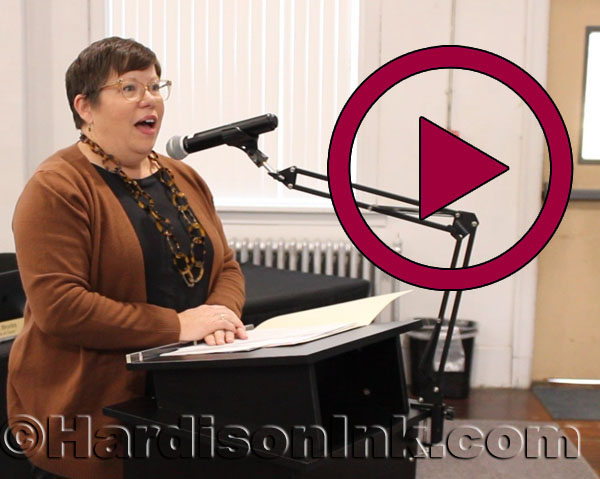
To see and hear the videotape of the offer former Levy County Attorney Nicolle M. Shalley presented on Nov. 4 to the County Commission after it fired her without cause and without warning via a 3-2 vote, click on the PHOTO. This includes her statement about having cancer and losing health insurance immediately and having to pay the exorbitant rate for COBRA insurance.
Video By Jeff M. Hardison – All Rights Reserved
By consensus too, the three county commissioners told Levy County Manager Mary-Ellen Harper and staff to send requests for proposals for legal firms, with a paralegal option for some work.
While the move forward is in place at a much higher cost than what existed before the sudden, non-agenda split-decision termination of employment of the county attorney -- and there is a strong likelihood of what will prove to be a shockingly higher cost for legal services than is budgeted for the Fiscal Year of Oct. 1, 2025 through Sept. 30, 2026, Shalley told the County Commission that she seeks less than what was offered for severance.
Shalley’s honorable offer is despite other attorneys saying the settlement offered by Levy County is not to be contested, because the cost to defend the termination of her employment will be more expensive than paying the severance amount.
As noted in an Oct. 30 memorandum from Nabors, Giblin & Nickerson, P.A., an independent law firm hired to help the Levy County Board of County Commissioner understand Florida law, that firm advised the commissioners to pay former Levy County Attorney Shalley the severance and leave payouts that a reasonable person and a civil circuit court judge or jury would likely deem is due her.
“While the Board (of Levy County Commissioners) appears to have reached a consensual understanding regarding the form and content of the Agreement with the former County Attorney that provided sufficient standards and oversight, without a formal vote this delegation arguably fell short of legal approval,” the contracted lawyers noted.
Upon review of facts and evidence in this civil matter of law, attorneys with Nabors, Giblin & Nickerson noted, in part, “From a legal perspective, the Agreement, as currently written, protects the County from potential future litigation with the County Attorney over the terms of her employment or termination, including wrongful termination claims, discrimination claims, and other potential legal disputes, because such claims are waived in exchange for the severance payment and leave payouts as set forth in the Agreement.
“Given these risks and that the expense of litigation could easily dwarf the amount of the severance and leave payouts, it is recommended that the Board vote to ratify the Agreement as written and abide by its terms,” Nabors, Giblin & Nickerson concluded.
Attorney Shalley, however, gave a very thoughtful presentation Tuesday, as well as providing the County Commission with facts in writing.
Shalley introduced herself from the lectern Tuesday as being the former attorney, as well as being a Levy County resident and Levy County taxpayer.
She said she was pleased to speak about the severance payment and release that was not discussed Oct. 21, when she was fired by Kennedy, Hiers and Meeks voting to do so, while Mills and Hodge voted against the Kennedy-Hiers motion.
She explained severance because apparently some people lack the facts and there is some misinformation spread as a result.
In states like Florida, a “right-to-work” state, employees may be terminated from their employment without cause. For instance, even if a person wears pink shirts and the boss dislikes pink shirts, the boss can fire the worker.
She listed other instances, including the ending of a position such as for a county coordinator when a county switches to a county manager form of government.
In any of those instances, she said, the employee is not being let go because he or she did something wrong, such as stealing, and they have not resigned. Their employment was simply terminated.
“Most human beings and most human resources policies recognize that can be really harsh on a person,” Shalley said. “And so most human resources policies, and Levy County’s included, address severance pay.”
She then quoted the existing county policy in this regard.
Severance pay, she explained, is not punitive to the employer; nor is it a gift or a reward to the employee who has been terminated. It simply helps that human cope with the circumstance in which the employer placed them.
In an email she sent to all five County Commission members, Shalley explained her off-the-cuff Oct. 21 request for the same severance the county paid to former County Coordinator Wilbur Dean as well as to, instead, make an alternative request.
Now, after further consideration during the past two weeks to consider this, she noted “I cannot in good conscience ask for, or take, 20 weeks of severance pay that will come from the Levy County taxpayers – which include my husband and I, my family, my friends and my neighbors.”
As noted in the previous story in Hardisonink.com about this event, Shalley asked for the opportunity to speak. She expressed her hurt and disappointment from that action on Oct. 21. As noted, she had served as county attorney for almost four years with no negative performance evaluations or conversations about dissatisfaction with her work.
“My livelihood – which allowed me to financially provide for my family – was about to be gone in an instant,” she noted in her email to the county commissioners. “I was shaken to my core, and, in that bitter moment, I requested the same severance the County provided to former County Coordinator Wilbur Dean. His was the only severance that I was familiar with during my time with the County and, my thought was that like me, Mr. Dean was a direct report to the Commission and did not have an employment agreement.”
When the meeting adjourned, Shalley went to her office and copied Dean’s form of agreement - changing only the name and facts, removing the clerk’s attest, and removing her “county attorney signature block” as to the form and legality.
She provided a signed copy of Dean’s agreement and an unsigned copy of the draft agreement to the board office, so both could be reviewed by Levy County Human Resources Director Jacqueline Martin.
“At no point did I discuss the substance of the draft Severance Agreement with the Chair or Jacqueline,” Shalley noted. “At no point did I provide legal guidance to the Board, to any individual Commissioner or to County staff regarding the termination or the Severance Agreement. I did exactly as I stated in the public meeting, I copied Mr. Dean’s form of agreement and provided a draft to Jacqueline.”
And although the Oct. 31 meeting included verbiage from the County Commission that this termination was immediate, Shalley noted in her email that it appears to not be immediate.
And given what happened at the Nov. 4 meeting, this matter is not over. It was not effective immediately.
“That is just as well,” Shalley noted in her email, “as I have now had the time to reflect on all that has occurred. The problem with handling County business in this manner - no notice, no agenda item, one vote and an immediate effective date – is that it gives no one time to think, to engage in meaningful discussion, to develop a plan or to contemplate a transition. I listened to the recording of the meeting. There was confusion and uncertainty.
“In haste and without stated reason or cause, the County was simply left without an attorney and an employee was left without a job,” she continued. “It even seemed a bit spiteful, when I offered a proper and professional transition of legal work to whomever the County selected as their next legal counsel and that offer was flatly rejected.”
Even with that, Shalley said she realized that she cannot in good conscience accept 20 weeks of severance pay from the county.
“Doing the right thing matters to me, far more than personal gain,” she said.
Instead of that offer from the county, she is asking for less. Shalley noted in the email and she told the three commissioners present for the Nov. 4 her modest proposal, which they failed to agree on, because Chair Mills felt all five commissioners should be present for this decision – given that two of the three who caused it were absent from the Nov. 4 meeting.
Here is what Shalley offered instead of the higher severance agreement.
● Payout of her accrued, but unused, sick leave and vacation leave that had accumulated as of Oct. 21, which the Levy County Human Resources Department has advised totals 237.9 hours.
These are benefits that Shalley earned while employed. She accrued these hours because it was difficult for her to take much time off. As the sole county attorney, no one did the legal work when she took a day off. She used outside counsel sparingly. Even through two rounds of cancer diagnosis, surgeries, radiation and chemotherapy treatments, the most recent of which was less than a year ago, she took sick leave only on days when she received medical treatment, and she recalls missing only one commission meeting in almost four years.
● $2,500 -- which will cover the cost of two months of the COBRA continuation of her county health insurance and the tax withholdings associated with that payment to her. This unexpected termination left Shalley immediately without health insurance coverage and an inadequate time to make other arrangements. This modest severance will provide the consideration for her release of legal claims against the County.
With these modifications, she asked the County Commission via the email to ratify the modified Severance Agreement and General Release at the Nov. 4 meeting.
Instead of agreeing to this reduced severance or to the severance previously submitted for approval by county staff, the three commissioners present chose to schedule a special meeting when Hiers and Meeks also both are available, since Meeks is going to miss the next regular County Commission meeting -- so that all five can discuss and vote on how to provide a severance agreement and general release to finally reach the “immediately effective” action from the Oct. 21 meeting.
Natasha Munkittrick Allen announces
candidacy for Dixie County Judge
Allen is first candidate
to announce on HardisonInk.com
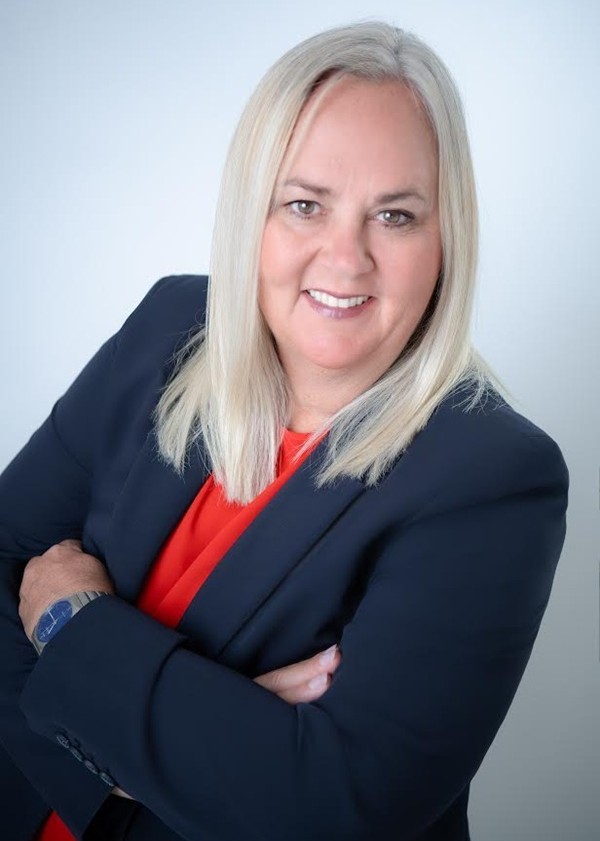
Information and Photo Provided
Published Oct, 3, 2025 at 9:45 p.m.
CROSS CITY -- Local attorney Natasha Munkittrick Allen has announced her candidacy for Dixie County Judge as of this evening (Monday, Nov. 3) via an email sent at 5 p.m. Pledging to bring fairness, honesty, and integrity to the bench, Allen, who has practiced law in Dixie and the surrounding counties for nearly a decade, says her campaign will focus on building public confidence in the judicial system through equal
treatment for all.
“Justice should never depend on who you know,” Allen said. “It should depend on what is right under the law. I believe in a courtroom where everyone -- no matter who they are, where they come from, or what they have -- is treated equally and with respect.”
Allen owns Allen Law Office, P.A., where she serves families throughout Dixie, Gilchrist and Levy counties in elder law, probate, estate planning, family law, and criminal matters.
Before entering the legal profession, she worked in television news as both a producer and as an on-air reporter.
A graduate of the University of Florida College of Journalism and Communications with a bachelor’s degree in telecommunication, Allen earned her Juris Doctor from the University of Florida Levin College of Law.
In addition to her legal work, Allen is deeply involved in the community. She helped found BACK Fighting Cancer, a nonprofit organization supporting families in the Tri-County Area who have children battling cancer. She is also a Paul Harris Fellow and an active member of the Dixie County Rotary Club and the Dixie County Chamber of Commerce.
Public service runs in Allen’s family. Her mother, the Honorable Cynthia S. Munkittrick, made history as Dixie County’s first female judge.
“My mother taught me that being a judge means listening before speaking, treating everyone with dignity, and following the law as it is written,” Allen said.
Allen and her husband, Patrick, have been married for nearly 25 years. Together they have two sons, Hunter and Austin, and attend First Baptist Church of Horseshoe Beach.
Her campaign slogan, “Fair. Honest. Firm. Justice for All of Dixie County,” reflects her commitment to equal justice and a courtroom guided by compassion, consistency and respect for the law.
Residents can learn more about Natasha Munkittrick Allen’s campaign, volunteer, or request a yard sign at https://natashafordixie.com/.
Publisher’s Note: Any candidate seeking any office in the Tri-County Area, or in the Eighth Judicial Circuit, or the Third Judicial Circuit, or for any state or federal office may announce their candidacy once for free.
If candidates buy ads, then all ads run on all seven pages and they all run together. They will be placed chronologically by when the check is received for payment. If two checks arrive on the same day, then there will be a coin toss to decide the placement. Ads cost either $400 a month or $1,500 a year. Candidates should send an email to hardisonink@gmail.com if they are interested in buying an ad or announcing their intent to run for any office.
Levy County Property Appraiser’s
Office moves to new location
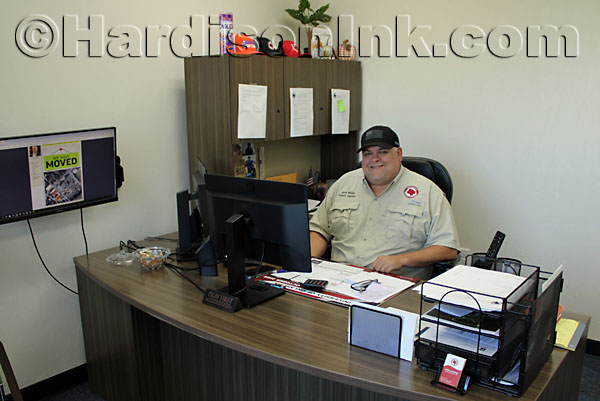
Levy County Property Appraiser Jason Whistler is seen in his new office at 355 Garner St. in Bronson. He and the nine employees in that office welcome opportunities to serve the public.
Story and Photos By Jeff M. Hardison © Oct. 30, 2025 at 12 p.m.
All Copyrights Protected By Federal Civil Law
Do Not Copy and Paste to Social Media or Elsewhere
BRONSON – The Levy County Property Appraiser’s Office has moved.
As of Wednesday afternoon (Oct. 29), the new office was operational with all services continuing through a smooth transition from one point on the Levy County Government Complex to another building.
Levy County Property Appraiser Jason Whistler, CFA, and the nine individuals who work with him in public service for the people of Levy County are now located at 355 Garner St. in Bronson.
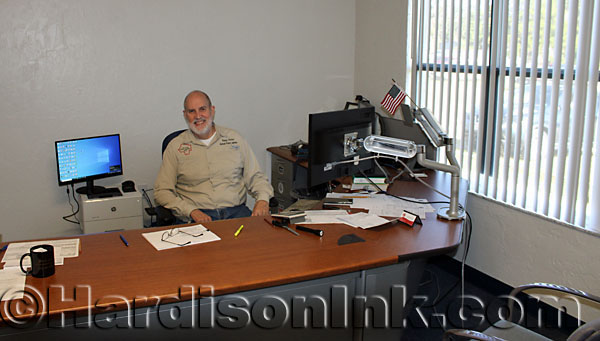
Assistant Property Appraiser Randy Rutter is seen in his new office.

The new break room at the Levy County Property Appraiser’s Office is ready for use. There is no sink or stove in it, because of the building codes. Dishes, therefore, are washed in other sinks on the property.
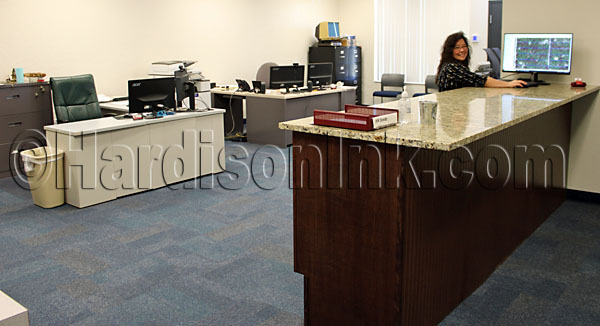
Tax Roll Assistant Lisa Shipp is seen at a computer on the front counter of The Map Room.
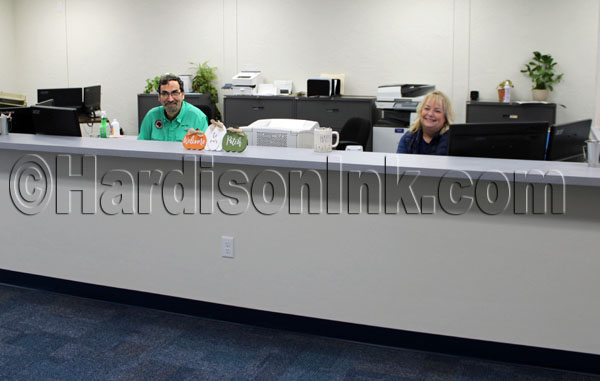
Late Wednesday afternoon (Oct. 28), Exemption Manager James Allen and Administrative Assistant Linda Jones are at the main counter ready to help people at the main reception area.
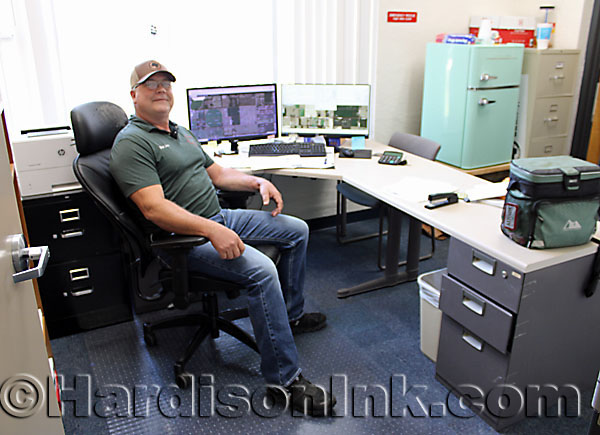
Brian Jones, who is the manager providing oversight for the residential appraisers (or field guys) as well as being the appraiser for agricultural and commercial properties in Levy County, is seen at his new desk.
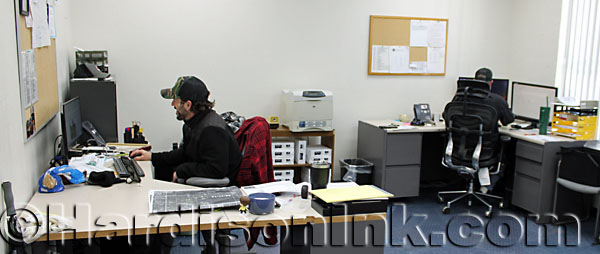
Field appraisers Justin Merando (left) and Patrick Libby (with his back to the camera) are so busy working with dedication to the people of Levy County on Wednesday that they could not take one-sixtieth of one second to face a camera for a photo opportunity. Libby had joked about adding value to the appraised worth of the photo by facing the camera.
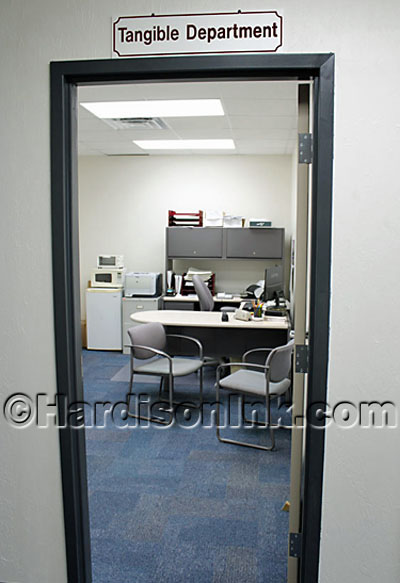
Here is the office where tangible property appraised values in Levy County are decided.
Approaching the Property Appraiser’s Office from the grassy parking lot next to Garner Street in Bronson shows one of the signs that help people find the door to enter. Follow the arrows...
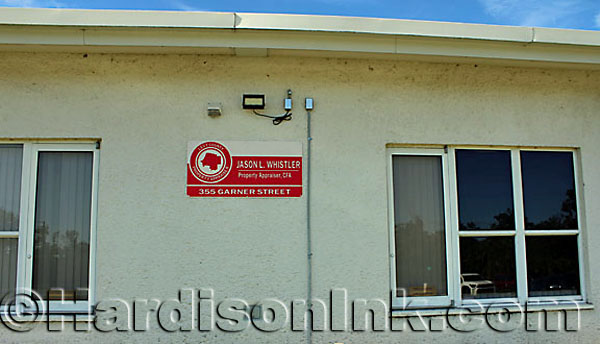
Looking from the parking lot, the red sign shows the address and name of the office inside this building.
Through these double doors, which are next to the metal dedication plaque of the late 1990s, people will enter the Levy County Property Appraiser’s Office – where public service is an extraordinarily high priority.
This structure is the former Bronson High School Classroom Building. It was dedicated in the 1998-1999 school year, when the Levy County School Board was comprised of Chairman Wayne E. Beauchamp, Vice Chairman Ted Alexander, and School Board members G. Frank Etheridge, Julia H. Haile and Jennefer Shuster, with Superintendent of Schools Paul D. Johnson.
The Levy County Commission took over the former Bronson High School campus in 2018. This acquisition for $1.5 million allowed for the consolidation of various county offices on the campus, as well as relieving stress at the Levy County Courthouse in regard to space required for the administration of justice in the civil and criminal legal realms of Levy County Court as well as this county’s part of the Eighth Judicial Circuit.
Since the 2018 purchase, the Levy County Government Complex (aka former BHS campus) and the Levy County Courthouse have both changed. Most of the offices and staff of the county commission, tax collector and property appraiser moved from the courthouse to the government complex.
Former Levy County Property Appraiser Francis Donald Akins (Sept. 24, 1946-July 6, 2024) wrapped up his service to Levy County in 2008,
Former Levy County Property Appraiser Akin was first elected in 1988 and then he was reelected and served for 20 years as the property appraiser for Levy County, according to records.
Then former Levy County Property Appraiser Osborn “Oz” Gray Barker (Dec. 24, 1964-Aug. 29, 2021) took office after he won the election in 2008 when he defeated Akins, according to records in the Office of Levy County Supervisor of Elections Tammy Jones.
Barker was reelected over and over, and he served the people of Levy County well and faithfully from 2008 until he died in 2021, according to records.
On Oct. 14, 2022, Gov. Ron DeSantis announced the appointment of Whistler as Levy County Property Appraiser. Whistler was subsequently elected during a special election in 2022 to serve the remainder of Barker’s term.
Whistler was reelected to a four-year term in 2024 when 69 percent of the voters chose him in a landslide election rather than another candidate, according to records.
Whistler’s office in the Levy County Government Complex used to be down the hallway from the main offices for the Levy County Board of County Commissioners, where the main entrance to that building was off of School Street.
Now it is on the same campus, but it is reached by taking a different route.
Now, the best method to reach the grassy parking area closest to the new office of the Levy County Property Appraiser’s Office is to drive on Court Street past the courthouse and then past Levy County Supervisor of Elections Tammy Jones’ Office, or coming from the other way on Court Street, past First Baptist Church of Bronson.
Turn from Court Street onto Garner Street, which runs between the church and the Supervisor of Elections Office. Cross through the intersection at Capital Street (after stopping at the stop sign). The building is well marked. Park in the grass.
Signs will point toward the door.
The main phone number remains as 352-493-5222. The website is at https://www.qpublic.net/fl/levy/.
The office is open from 8:30 a.m. to 4:30 p.m. Monday through Friday, except holidays.
Whistler said he was approached by the Levy County Board of County Commissioners to move his office from the main building to its new location to allow for County Commission staff to have the office space they needed.
The County Commission’s administration wanted all of their staff on that wing of the campus, Whistler said. There was a point, before the County Commission in a 3-2 vote to fire Levy County Attorney Nicolle M. Shalley, where the county attorney would be in Whistler’s former office in that wing of the campus, he said. The former front office for Whistler would have been the place for the administrative assistant to the county attorney.
Although the move took some work, Whistler is pleased with the new location.
“I am very happy,” Levy County Property Appraiser Whistler said now that the move is complete.
The new set of offices includes about 5,500 square feet, where the previous location was about 2,000 square feet.
The only disadvantage is that access for people who use crutches, wheelchairs, rollators and the like, and who park in the grassy parking lot, will see some challenges -- because it is essentially grass, shells and soil rather than being asphalt or concrete.
The entrance from the current grassy parking lot may not be completely compliant with the ADA, which is an acronym for the Americans with Disabilities Act.
The ADA is a landmark United States civil rights law that prohibits discrimination against people with disabilities in various areas of public life. It requires employers, business owners and government agencies to provide reasonable accommodations, and to ensure accessibility for people with disabilities.
Examples of compliance with the ADA include making public buildings accessible with ramps and elevators and requiring employers to provide workplace modifications.
Whistler said he knows that ever since he started working for Property Appraiser Akins in 2000 and then Property Appraiser Barker in 2008, and every minute he has held this office, he and every single employee of this office strives to serve the public as best as they can.
Whistler said sometimes people call his office even if it is for a public service that only some other elected or appointed officials can complete, because this county property appraiser and his staff will do what they can to direct people to the best means they know to meet an objective.
With That philosophy in mind, Whistler or one of his employees will come out to a vehicle and help the handicapped person there in their vehicle, or the staff will do what they can to transport the person into the office for the public service they can render inside.
The inside of this new location is already welcoming; however, the property appraiser said he intends to add some décor to make it have even more of a comforting atmosphere – like being at home.
TCCRC helps overcome
food insecurity and more
By Jeff M. Hardison © Oct. 27, 2025 at 4 p.m.
All Copyrights Protected By Federal Civil Law
Do Not Copy and Paste to Social Media or Elsewhere
CHIEFLAND – With the impending stoppage of Supplemental Nutrition Assistance Program (SNAP) (formerly known as Food Stamps) benefits for families, the Tri-County Community Resource Center (TCCRC) recently noted it continues to be a place to seek help.
“Our goal is to make sure no one in our community feels alone when they’re struggling. We’re here to connect people with resources that can help - whether that’s food assistance, employment support, or simply a place to start when they don’t know where else to turn.”
-- TCCRC Manager Beverly Goodman
When households experience food insecurity, TCCRC can help connect individuals and families to local food pantries and upcoming food distributions throughout the Tri-County Area of Levy County, Gilchrist County and Dixie County.
The Resource Center keeps a small supply of emergency food onsite for households experiencing a short-term food crisis. In addition, TCCRC can help residents with job searches, online applications, and other support to help strengthen household stability.
“Our goal is to make sure no one in our community feels alone when they’re struggling,” TCCRC Manager Beverly Goodman said. “We’re here to connect people with resources that can help - whether that’s food assistance, employment support, or simply a place to start when they don’t know where else to turn.”
Donors can join the partnership for strong families, too.
For those individuals who want to support their neighbors in need, donations of nonperishable food items can be dropped off during business hours, 9 a.m. to 4 p.m. (closed for lunch daily, 12-1 p.m.) at the TCCRC.
There is also the TCCRC’s Free Tiny Pantry, located outside the Resource Center, and it is available 24-hours-day, seven-days-a-week for anyone who would like to give what they can or take what they need.
The Tri-County Community Resource Center is located at 15 N.W. First St., in Chiefland. The phone number is 352-507-4000.
The website for Partnership for Strong Families, of which the TCCRC is a resource center, is https://www.pfsf.org/resourcecenters/.
19oth Performance
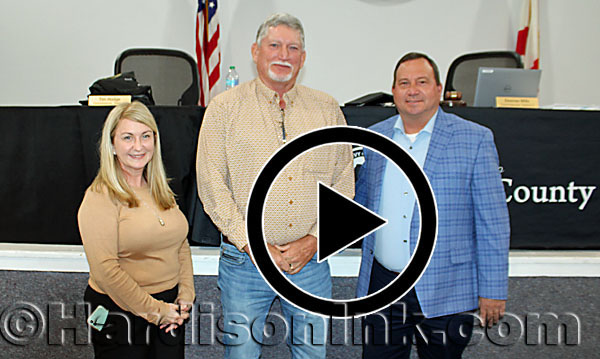
The three members of the Levy County Board of County Commissioners present for the Oct. 4 meeting perform the HardisonInk.com jingle in the Levy County Government Center Auditorium on Oct. 4, 2025. Seen here (from left) are Chair Desiree Mills, Vice Chair Tim Hodge, and Levy County Commissioner Charlie Kennedy. Commissioners Johnny Hiers and Rock Meeks were absent from that meeting. This group marks the first county commissioners to sing the jingle. There have been entire groups of people performing the jingle, including from the Levy County Supervisor of Elections Office as well as some trustees for Central Florida Electric Cooperative. Mark “Clawhammer” Johnson is the only professional performer who has played the jingle as a solo hit on the banjo, so far. Jeff M. Hardison asks people to sing the jingle, and some of them agree to sing it. (Thanks people!) CLICK ON THE PICTURE ABOVE TO SEE AND HEAR THE VIDEO ON YouTube.com. The very first person to sing the jingle was in Chiefland in March of 2013. HardisonInk.com started as a daily news website on Feb. 1, 2011.
Photo and Video by Jeff M. Hardison © Nov. 4, 2025 at 8 p.m.
All Rights Reserved Do Not Copy And Paste Anywhere




